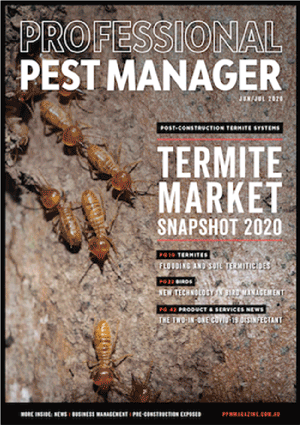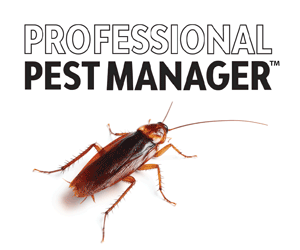Lindsay McRae, Regional Manager at FMC, outlines the most effective control methods for two common ant species.
Several nuisance ant species make their presence felt during the summer months. Two of the most common nuisance ants – white-footed ant and funnel ant – are discussed here, including details about their appearance, status, nesting and feeding habits, and options for control.
White-footed ant (Technomyrmex jocosus)
The white-footed ant (pictured above) includes both native (T. jocosus) and introduced (T. albipes) species in Australia. This ant typically prefers to nest outdoors in trees, but it is also one of the few ant species capable of nesting indoors. You can often find it in roof voids and wall cavities, electrical equipment, rolled-up awnings, and potted plants.
The white-footed ant is small, measuring 3.0-3.5 mm in length, is dark brown to black in colour and is characterised by its distinctive white feet and single-sized workers. They have a pointed abdomen which they can raise when breathed on. Not to be confused with the acrobat ant which raises its similarly pointed abdomen when walking on trails. They have no bite or sting.
The white-footed ant primarily builds its nests above ground, both internally and externally, and it has the ability to form super-colonies through interconnected nests, which separate off through the process of budding.
Although they are omnivorous, they prefer sweet food, foraging in trees for honeydew and nectar.
Treatment for white-footed ants
Treatment for the white-footed ant requires a coordinated, multi-pronged approach. Firstly, foraging trails should be baited. Secondly, any identified nests should be treated by direct nest application with liquid and/or granules. Thirdly, to prevent ingress, a liquid insecticide should be applied to the building perimeter. Internal crack and crevice harbourages should be treated with aerosol/dust and bait.
Lastly, hygiene measures should be taken, such as cutting back foliage from the external walls of the building, cleaning gutters of debris, disposing of rubbish promptly and sealing cracks and crevices. It is important that the customer is educated on the importance of continuing these practices.
Funnel ant (Aphaenogaster spp.)
Native to Australia, the funnel ant’s unsightly funnels from their nesting activity can devalue people’s homes. From a practical point of view, the funnels can damage mower blades and subsidence creates an uneven lawn, with the potential to cause injury to users.
This medium-sized ant measures 3-5 mm long, has a tan to honey-brown colouration, and is distinctive with its long slender legs. The workers vary in size and have painful stings.
Funnel ants are named for their funnel-shaped nest entrances, which are built after heavy rainfall. With a single queen per colony, these ants nest underground.
The funnel ant is a nocturnal forager and generalist feeder, consuming both plant and animal materials. It tends to aphids on plant roots, and catches beetles and other animals that fall into its funnels.

Treatment for funnel ants
The treatment for the funnel ant is a direct nest application of either liquid and/or granules. All products in the FMC general pest range carry an ant registration. Notably Biflex Mikron and Astro also have HACCP approval while along with Biflex Ultra, Biflex Aqua and Fury are registered for internal use. Externally, Brigade Granular is a popular option around perimeters, paved and lawn areas while Dragnet Dust offers an excellent option for roof voids and wall cavities.
It is important in every situation that an IPM (integrated pest management) program is adopted, within which FMC product(s) can always be incorporated.
Lindsay McRae, Regional Manager – NSW & ACT, FMC


